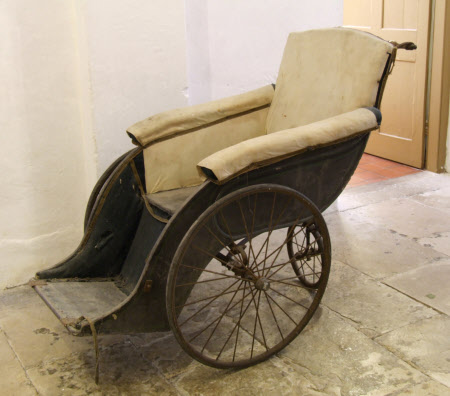Invalid carriage
Alfred Carter
Category
Carriages & other vehicles
Date
Unknown
Materials
Painted wood body with wool cloth upholstery and two rubber shod wheels.
Measurements
111 x 155 x 85cm (3ft 7 3/4in x 5ft 1in x 2ft 9 1/2in)
Place of origin
London
Order this imageCollection
Uppark House and Garden, West Sussex
NT 137716
Caption
Invalid carriages were designed either to be pulled by a small pony or donkey or pushed along by a servant, relative or friend. This example is person propelled via the carved wood handle at the back. They were a means of enabling the elderly or infirm to take some air. This invalid carriage is unusual as it has two wheels at the front and the single wheel at the back. It has a panelled body with curved profile. There would have once been a leather apron attached to the front to provide a little extra warmth to the occupant.
Summary
Invalid Carriage built by Alfred Carter, of 47 Holborn Viaduct, London. Invalid Carriage (three wheels) designed to be propelled by an attendant. The body of this carriage is panelled body with a curved profile and is sprung on cross springs. There is a high seat back, long arm rests, and a deep foot rest with panelled sides. The turned wood pushing handle is on curved iron stays bolted to the back of the body. There are half hinges at the front of the foot rest showing that a framed apron was originally fitted, and studs beneath the arm rests for a leather apron above this. Neither apron has survived. Upholstered in dark blue and undyed cloth. Painted dark blue with pale blue lining.
Full description
This invalid carriage is unusual as it has two wheels at the front and the single wheel at the back. It has a panelled body with curved profile. There would have once been a leather apron attached to the front to provide a little extra warmth to the occupant. Invalid carriages were designed either to be pulled by a small pony or donkey or pushed along by a servant, relative or friend. This example is person propelled via the carved wood handle at the back. They were a means of enabling the elderly or infirm to take some air.
Provenance
Donated by Admiral Sir Herbert Meade and Richard Meade-Fetherstonhaugh in 1954
Marks and inscriptions
On plaque on the back.: ALFRED CARTER / 47 / HOLBORN / VIADUCT / LONDON, E.C.
Makers and roles
Alfred Carter, coach builder
